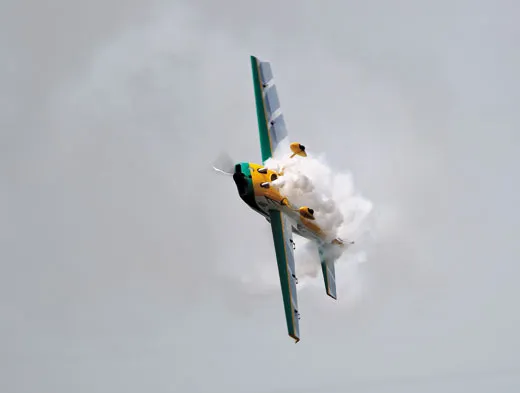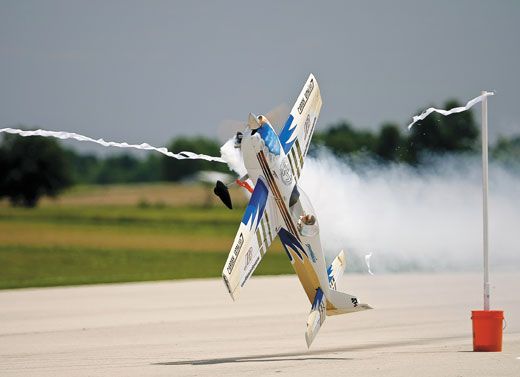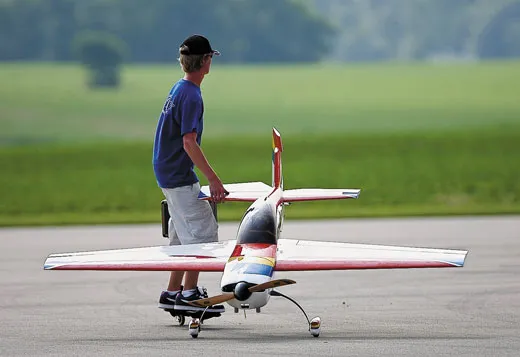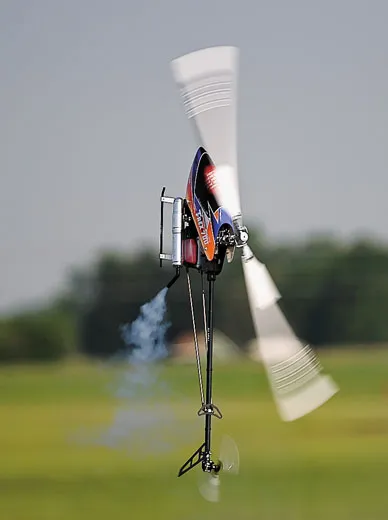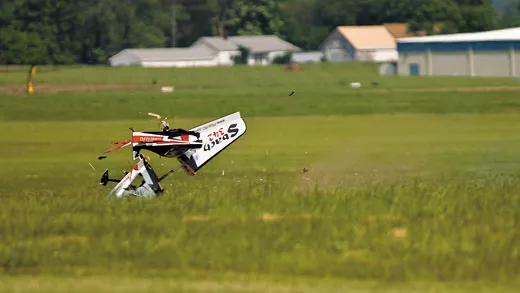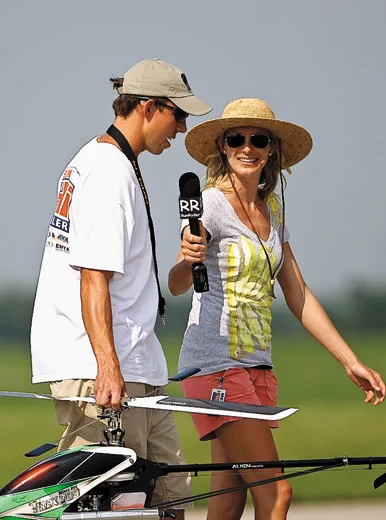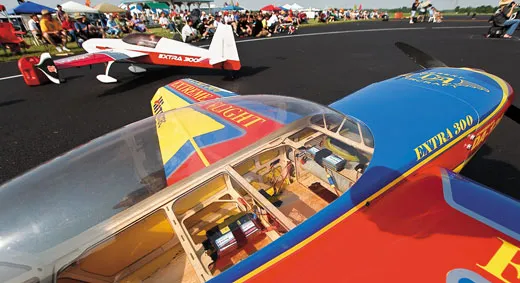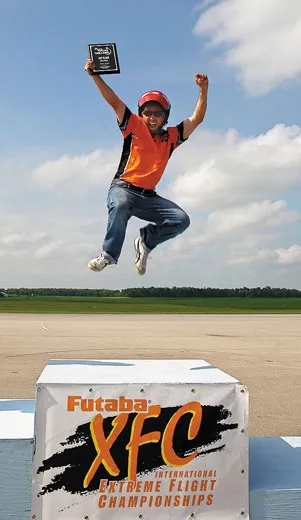The Kids Are Trying to Crash
Remote-control models face off in the Extreme Flight Championships.
/https://tf-cmsv2-smithsonianmag-media.s3.amazonaws.com/filer/Kids-Crash-Chris-Fry-Extra-330-FLASH.jpg)
The Slick 540 rolls low and slow over the runway, the monoplane’s nose pointed up at a 45-degree angle that seems to defy the laws of physics. Then the aerobatics get really radical: The airplane rotates to a higher nose-up attitude so the wings are developing absolutely no lift—zero, zilch—and hangs like a helicopter on its propeller, hovering with the tail a breathtaking few inches from the pavement. At this point, the Slick looks more like a levitating cross than a flying machine.
Okay, so this isn’t a real airplane; it’s a 35-percent scale model of the Slick 540, which is best known as a competitor in the Red Bull Air Races. And the pilot isn’t an aerobatics hot dog who’s dancing on the rudder pedals. He’s a hobbyist flying the radio-control—or remote-control— airplane from the runway with a pair of sticks attached to a radio transmitter. “That’s low enough,” his spotter tells him. So 21-year-old Jamie Hicks calmly uses his left thumb to apply full throttle and his right thumb to activate the right aileron. The Slick leaps back into the sky.
Such maneuvers are routine for Hicks and the other RC pilots competing at the accurately titled Extreme Flight Championships. Staged at the Academy of Model Aeronautics’ magnificent 1,000-acre site in Muncie, Indiana, the competition features the finest in what’s known as 3D flight. To borrow U.S. Supreme Court Justice Potter Stewart’s famous description of pornography, 3D flight is difficult to define, but you know it when you see it.
Generally speaking, 3D maneuvers are performed at high angles of attack, a departure from level flight that leaves less air to pass over and under the wings. At this point, the wings stall, or stop developing lift, and the airplane assumes the flying qualities of a two-by-four. So in the real world, high-angle-of-attack maneuvers are a “kids, don’t try this at home” proposition, limited largely to aerobatics and dogfights.
In addition to his radio-control stunt flying, Hicks is also a student pilot who eventually hopes to fly commercially, but he knows he’ll never be able to do in a full-size airplane what he can execute with his scale-model Slick. “These airplanes are getting to be so indestructible that you can do almost anything,” he says after completing his freestyle routine. “We’ve got larger control surfaces and much more power [proportionately] than full-scale airplanes. A real person can handle about 10 Gs, but we’re probably generating 10 to 15. It’s ridiculous.”
Even more ridiculous are radio-control helicopters. In the hands of superstar pilots like 17-year-old Jamie Robertson and 21-year-old Nick Maxwell, model helis dart through the air like dragonflies on amphetamines. They don’t seem to be flying so much as animated by CGI artists—or possessed. They zoom backward, hover upside down, spiral, and tumble like race cars crashing out of a video game. “We’re pretty much limited only by our imagination,” says Robertson.
But even though scale models are designed to mimic their full-scale counterparts, remote-control airplanes diverge from them in several significant ways. To begin with, they’re much, much lighter, proportionately, thanks to airframes built out of balsa wood and plywood. And they’re powered by remarkably efficient two-stroke motors. The thrust-to-weight ratio of a modern jet fighter is about 1:1. Most of the airplanes at the Extreme Flight Championships, however, have a thrust-to-weight ratio from 2:1 to 3:1. So even when their wings aren’t generating lift, their propellers can keep them flying.
All that propeller power has enabled the development of a thick playbook of 3D maneuvers. There’s the Harrier (flying with the nose at a 45-degree angle), the Torque Roll (spinning in place like a drill bit), the Elevator (a rapid descent in a full stall), the Blender (a diving roll into a flat spin), the Waterfall (a flopping 360-degree flip), the Knife Edge (flying sideways with the nose 45 degrees high), and so on. Real-world stunt routines look awfully prosaic by comparison.
“The top aerobatics pilots pay attention to what we’re doing,” says Jason Danhakl, who has seen real-world pilots start to incorporate 3D techniques culled from the remote-control world into their aerobatic routines. “A lot of them even fly scale RC models. It’s so easy for us to expand the flight envelope because, number one, we’re not sitting inside the cockpit, and number two, the airplane doesn’t cost $300,000.”
At 34, Danhakl is one of the few competitors who’s been flying long enough to remember the dawn of the 3D age—at the Tournament of Champions in 1994. Besides offering serious prize money, the tournament was unique because it featured a freestyle component along with traditional RC disciplines such as precision flying. So instead of flying according to prescribed patterns, competitors performed anything-goes routines to music blasting from public-address systems.
A handful of competitors had already begun experimenting with what are now recognized as 3D maneuvers. But an Argentine named Quique Somenzini was the first to put together a genuine 3D routine, and many of the moves he wowed the crowd with are still being performed. “It was amazing,” says Sean McMurtry, a 35-year-old competitor who attended the ’94 tournament as a spectator and still speaks about it with awe. “Nobody had ever seen anything like that before.”
Word of Somenzini’s exploits spread, and before long, so did many of his techniques. The knowledge base expanded through online tutorials, and new generations of remote-control flight simulators enabled pilots to experiment virtually, without destroying real airplanes. At the same time, models got lighter and more powerful. Control surfaces—ailerons, elevators, and rudders—were enlarged and given wider ranges of movement, and electronics and servos improved dramatically. Still, the biggest change, in many respects, is one that isn’t immediately visible to outsiders. From the earliest days of model aviation, the hobby has been a builder’s sport, and it wasn’t uncommon for pilots to spend months, sometimes years, fabricating and assembling their airplanes. In recent years, though, the industry has gone almost exclusively to almost-ready-to-fly kits: The aircraft can be put together in a weekend.
ARF kits offer great value, but they aren’t cheap. (Most of the entrants in the Extreme Flight Championships have invested between $4,000 and $5,000 in what is considered top-of-the-line equipment.) But there’s something to be said for instant gratification, and the ARF approach appealed to a new breed of RC hobbyist, who was gung-ho about flying yet had no interest in painstakingly building a model. Meanwhile, as the emotional attachment between airplane and pilot eroded, so did the fear of risky 3D maneuvers. Says Donatas Pauzuolis, a competitor from Lithuania: “If each pilot had to build a plane, we wouldn’t have competition like this.”
The last Tournament of Champions was staged in 2002. The same year, RC aviation stalwart Frank Noll inaugurated the Extreme Flight Championships (XFC). Instead of faithfully following the old tournament’s format, he focused on its most crowd-pleasing element—the freestyle event—and he opened up the competition to helicopters. The XFC is now the premier event of its kind in the world, and this year’s invitation-only field includes entrants from South Africa, Brazil, the United Kingdom, Germany, Lithuania, Taiwan, Canada, Mexico, and Puerto Rico.
The competition is so stiff that pilots are forced to push themselves—and their aircraft. “We want to see ailerons scraping,” announcer Bob Sadler, billed as the “Mouth of the South,” booms over the loudspeaker. “We want to see rudders scraping. We want to see the inside of the canopy scraping. After all, this is called the Extreme Flight Championship, not the Fairly Extreme Flight Championship.”
The carnage isn’t as bad as you might expect. But with powerplants and airframes being stressed so severely, propulsion and structural failures are inevitable. There are also a handful of crashes attributed to pilot error, known in the hobby as “dumb thumb.” Victor Aponte destroys his 36-percent Sbach 342 while performing a rolling Harrier a few feet off the deck. “Don’t worry, Victor!” Sadler crows good-naturedly over the P.A. as the wreckage is carted off. “They build more of them every day!”
Most of the competitors are very young. This is especially true on the heli side, where most of the entrants have yet to shave. It’s the nature of the sport: With everything seeming to happen at warp speed, the game requires a youngster’s lightning-quick reflexes, little or no memory of past disasters, and the luxury of time for endless hours of practice. At the same time, several older stars have left the hobby to pursue remote-control flying as a career. Helicopter pilots are in high demand for movie and commercial shoots, and fixed-wing guys have landed jobs in the development of unmanned aerial vehicles for military and civilian applications.
Still, there’s a sense, particularly among RC veterans, that 3D is stagnating. The glory days, they say, were the 10 years after Somenzini’s triumph, when pilots struggled mightily to overcome the limitations of airplanes that would today be considered junk. Technology has improved dramatically since then, and so has flying technique. Some young hotshots consider the Torque Roll and other classic 3D stunts so cliché that they no longer perform them. Routines have become faster and more aggressive, with more moves packed into ever smaller slivers of time and space. “The flying style has changed more than anything,” says Noll. “The kids are trying to crash every time they fly. But in terms of new maneuvers, I think we’ve hit a wall, at least on the scale airplane side.”
Which raises an interesting point. The Extreme Flight Championships are limited to aircraft models because that was the legacy of the Tournament of Champions—and that’s primarily what the model industry sells. But considering that RC pilots are flying routines that real-world pilots can’t replicate, some visionaries argue the hobby ought to loosen its ties to full-scale aviation. To a certain degree, this has already begun. Attached to the wings of several airplanes at this year’s competition are plates called side-force generators, which produce lift while the craft is flying in a knife-edge attitude.
And a groundbreaking form of aerobatics sometimes referred to as 4D is emerging. It uses “foamies”—smaller radio-control model airplanes made of foam—that are light as a feather, cost next to nothing, and are easy to repair if they are damaged in a crash. But some of them incorporate technology that would make an F-16 pilot green with envy. Motors mounted on a pivot allow them to vector thrust. Propeller pitch can reverse direction, enabling some foamies to fly backward and hover upside down, a perfect example of RC airplanes going where their real-world counterparts cannot.
“That’s why I hope Frank will open up the regulations for the XFC,” says Chris Hinson, the owner of Extreme Flight RC, which sells a variety of airplane models. The son of a U.S. Navy P-3 Orion pilot, Hinson has been around airplanes since he was a child, and he has devoted his adult life to the RC industry. “We’ve come full circle,” he says. “We started out emulating full-scale airplanes. But now that top aerobatic pilots are following us, why can’t we take the lead and expand the boundaries?”
Sounds like a plan. Can the Mega-Extreme Flying Championships be far away?
Longtime contributor Preston Lerner last wrote for the magazine about the Sidewinder air-to-air missile (Oct./Nov. 2010). Photographer Mark Fadely enjoys making inflight images of everything from radiocontrol aircraft to birds.
